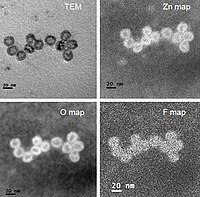
Photo from wikipedia
This work demonstrates a bioenabled fully aqueous phase and room temperature route to the synthesis of CuInS2/ZnS core/shell quantum confined nanocrystals conjugated to IgG antibodies and used for fluorescent tagging… Click to show full abstract
This work demonstrates a bioenabled fully aqueous phase and room temperature route to the synthesis of CuInS2/ZnS core/shell quantum confined nanocrystals conjugated to IgG antibodies and used for fluorescent tagging of THP-1 leukemia cells. This elegant, straightforward and green approach avoids the use of solvents, high temperatures and the necessity to phase transfer the nanocrystals prior to application. Non-toxic CuInS2, (CuInZn)S2, and CuInS2/ZnS core/shell quantum confined nanocrystals are synthesized via a biomineralization process based on a single recombinant cystathionine γ-lyase (CSE) enzyme. First, soluble In-S complexes are formed from indium acetate and H2S generated by CSE, which are then stabilized by l-cysteine in solution. The subsequent addition of copper, or both copper and zinc, precursors then results in the immediate formation of CuInS2 or (CuInZn)S2 quantum dots. Shell growth is realized through subsequent introduction of Zn acetate to the preformed core nanocrystals. The size and optical properties of the nanocrystals are tuned by adjusting the indium precursor concentration and initial incubation period. CuInS2/ZnS core/shell particles are conjugated to IgG antibodies using EDC/NHS cross-linkers and then applied in the bioimaging of THP-1 cells. Cytotoxicity tests confirm that CuInS2/ZnS core/shell quantum dots do not cause cell death during bioimaging. Thus, this biomineralization enabled approach provides a facile, low temperature route for the fully aqueous synthesis of non-toxic CuInS2/ZnS quantum dots, which are ideal for use in bioimaging applications.
Journal Title: Nanoscale
Year Published: 2017
Link to full text (if available)
Share on Social Media: Sign Up to like & get
recommendations!